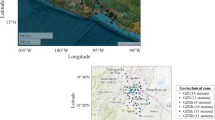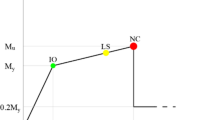Abstract
Estimating seismic demands on structures, to predict their performance level with confidence, requires explicit consideration of the structural inelastic behaviour: to this end, the use of nonlinear static procedures is inevitably going to be favoured over complex nonlinear time-history methods.
The currently available assessment procedures have been tested predominantly against building frames. A newly derived assessment procedure is proposed within the scope of bridge applications, based on an innovative displacement-based adaptive pushover technique. The procedure, which can be incorporated into a performance-based engineering philosophy, is applicable to MDOF continuous span bridges with flexible or rigid superstructures, and for varying degrees of abutment restraint.
As a first application to determine the viability of the proposed procedure, a parametric study is conducted on a ensemble of bridges subjected to earthquake motion. It is shown that, compared to the seismic demand estimated by means of the more accurate nonlinear dynamic analysis tool, the novel static assessment method can lead to the attainment of satisfactory predictions, both in terms of displacement as well as moment demand on members.
Similar content being viewed by others
References
Antoniou S, Pinho R (2004) Development and verification of a displacement-based adaptive pushover procedure. J Earthquake Eng 8(5):643–661
Applied Technology Council (1996) Seismic evaluation and retrofit of concrete buildings, ATC-40 Report, Vol 1 and 2, ATC, California, USA
Bommer JJ, Martinez-Pereira A (1999) The effective duration of earthquake ground motion. J Earthquake Eng 3(2):127–172
Casarotti C, Pinho R, Calvi GM (2005) Adaptive pushover based methods for seismic assessment and design of bridge structures. ROSE Research Report No. 2005/06, IUSS Press, Pavia, Italy
Chopra AK, Goel RK (1999) Capacity–Demand–Diagram methods based on inelastic design spectrum. Earthquake Spectra 15(4):637–656
Chopra AK, Goel RK (2000) Evaluation of NSP to estimate seismic deformation: SDF systems. ASCE J Struct Eng April 2000, 482–490
Chopra AK, Goel RK (2002) A modal pushover analysis procedure for estimating seismic demands for buildings. Earthquake Eng Struct Dyn 31:561–582
Elnashai AS (2001) Advanced inelastic static (pushover) analysis for earthquake applications. Struct Eng Mech 12(1):51–69
Fajfar P (1999) Capacity spectrum method based on inelastic demand spectra. Earthquake Eng Struct Dyn 28:979–993
Fajfar P, Gaspersic P, Drobnic D (1997) A simplified nonlinear method for seismic damage analysis of structures. Proceedings of the workshop on seismic design methodologies for the next generation of codes, Rotterdam, pp 183–193
Fischinger M, Beg D, Isaković TA, Tomaževič M, Žarnić R (2004) Performance based assessment—from general methodologies to specific implementations. International workshop on performance-based seismic design, bled, June 28/July 1
Freeman SA (1998) Development and use of capacity spectrum method. Proceedings of the 6th US national conference on earthquake engineering, Seattle, CD-ROM, EERI, Oakland
Freeman SA, Nicoletti JP, Tyrell JV (1975) Evaluations of existing buildings for seismic risk—a case study of Puget Sound Naval Shipyard, Bremerton, Washington. Proceedings of the 1st US national conference on earthquake engineering, Oakland, California, pp 113–122
Goel RK, Chopra AK (1997) Evaluation of bridge abutment capacity. Earthquake Spectra 13(1):225–254
Chopra AK, Goel RK (1999) Capacity–Demand–Diagram methods based on inelastic design spectrum. Earthquake Spectra 15(4):637–656
Isakovic T, Fischinger M (2006) Higher modes in simplied inelastic seismic analysis of single column bent viaducts. Earthquake Eng Struct Dyn 35:95–114
Kowalsky MJ (2000) Deformation limit states for circular reinforced concrete bridge columns. J Struct Eng 126(8):869–878
Mander JB, Priestley MJN, Park R (1988) Theoretical stress-strain model for confined concrete. J Struct Eng 114(8):1804–1826
Menegotto M, Pinto PE (1973) Method of analysis for cyclically loaded R.C. plane frames including changes in geometry and non-elastic behaviour of elements under combined normal force and bending. Symposium on the resistance and ultimate deformability of structures acted on by well defined repeated loads, International Association for Bridge and Structural Engineering, Zurich, Switzerland, pp 15–22
Newmark NM, Hall WJ (1982) Earthquake spectra and design. Earthquake Engineering Research Institute, Berkeley
Priestley MJN, Seible F, Calvi GM (1996) Seismic design and retrofit of bridge structures. Wiley, New York
Priestley MJN, Calvi GM (2003) Direct displacement-based seismic design of concrete bridges. Proceeding of the fifth ACI international conference of seismic bridge design and retrofit for earthquake resistance, December 8–9, 2003, La Jolla, California
Reinhorn A (1997) Inelastic analysis techniques in seismic evaluations. In: Seismic design methodologies for the next generation of codes: proceedings of the international workshop, Bled, Slovenia, pp 277–287
SAC Joint Venture (1997) Develop suites of time histories, Project Task: 5.4.1, Draft Report, March 21, 1997, Sacramento, CA, USA
Seismosoft (2005) Seismostruct—a computer program for static and dynamic nonlinear analysis of framed structures (online), available from URL: http//www.seismosoft.com (March 30, 2005)
Takeda T, Sozen M, Nielsen N (1970) Reinforced concrete response to simulated earthquakes. ASCE J Struct Div 96(12):2557–2573
Author information
Authors and Affiliations
Corresponding author
Rights and permissions
About this article
Cite this article
Casarotti, C., Pinho, R. An adaptive capacity spectrum method for assessment of bridges subjected to earthquake action. Bull Earthquake Eng 5, 377–390 (2007). https://doi.org/10.1007/s10518-007-9031-8
Received:
Accepted:
Published:
Issue Date:
DOI: https://doi.org/10.1007/s10518-007-9031-8




